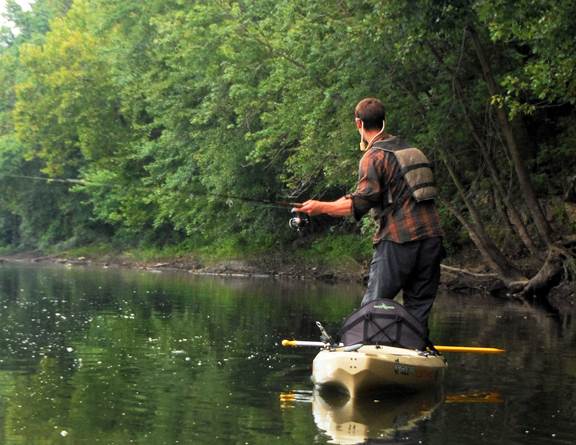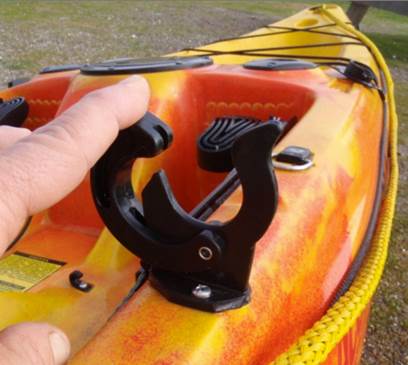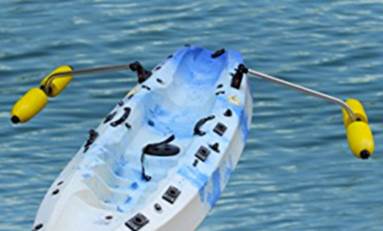TIPS FOR RIGGING YOUR KAYAK FOR FLY FISHING
 For consumers who are interested in fly fishing from a kayak, the first step it to invest in a high-quality, well-known brand. If you have been in the market for some time, you will probably understand the difficulties of choosing just one from the many available models.
For consumers who are interested in fly fishing from a kayak, the first step it to invest in a high-quality, well-known brand. If you have been in the market for some time, you will probably understand the difficulties of choosing just one from the many available models.
Kayaks for a single paddle is probably what you are looking for, because they are extremely easy to use and offer tons of stability.
Once you find the kayak that suits your preferences, needs and wallet, it will be time to rig it for fly fishing.
Install Paddle Holders
Fly fishing can offer an immense amount of fun, but you will need to have both of your hands free to manipulate the rod, cast the fly and hold the reel. You'll learn this first hand when delving into the basics of fly fish casting. This basically means that you will need to put the paddle in the kayak, while you are fishing. However, by doing this you may end up limiting your flexibility, which is crucial for a successful fly fishing endeavor.
Another option is to install a paddle clip on the side of the kayak. There are several different types of paddle clips, one that installs with screws and another with super glue, which is more suitable for inflatable kayaks.
Once the paddle clip is installed on the watercraft, you will be able to clip the paddle in place prior to casting the fly.

Outfit the Kayak with Outriggers
Maintaining balance on a kayak can be extremely difficult, especially when you are fly fishing. Therefore, many experts recommend outfitting the kayak with an outrigger.
While many people choose to customize their own outrigger, you can purchase one with only a bit of assembly required. A 32-inch outrigger constructed from aluminum will be your best bet, because aluminum is lightweight and fairly durable. The outrigger will be equipped with molded PVC floats to keep the kayak balanced, while paddling and fly fishing.

The lightweight design will not alter the kayak's portability rating, which is crucial for all kayakers since they oftentimes need to carry their gear significantly long distances.
Now, if you decide to with the DIY route, it will still be a good idea to stick with aluminum, because you do not want to add any extra weight to your load. It is important to note that the farther the outrigger is from the centerline of the kayak, the higher the stability.
Once the outrigger is installed, you will notice a remarkable difference in how the kayak controls. In fact, if the outrigger is installed properly it will be able to resist the downward pressure of your body weight. For required accessories, you should check out the recommendations provided by South Texas Kayak.
A Deck Board for Standing
If you want to get the most out of your fly fishing adventure, you may want to consider installing a deck board in the kayak. Again, you will have the option of customizing your own deck board, which will need to sit directly inside the cockpit. You can construct the board from some type of durable material, such as ¾-inch plastic or wood.
The only way you can utilize a deck board on a kayak is if it's installed with an outrigger, which will offer enough stability to keep your body balance, while you are fly fishing.
If you are looking for a deck board that is more modern, you can purchase one that will attach to the top of the kayak above the seat. These deck boards are available in various sizes and come with web bolts, which will allow for quick and easy attachment and detachment capabilities.
You can actually install the deck board in a location that suits your needs and preferences better, but just make sure your kayak is equipped with an outrigger, before attempting to stand on the deck board.
Upgrade the Seat
Most kayaks are equipped with a seat that is not suitable for fly fishing, which is why many kayakers choose to upgrade immediately after purchase. You will find an array of seats available on the market that will enhance your fly fishing skills.
An elevated sit-on-top seat with straps that attach directly to the top of the kayak will be your best option. A seat constructed out of thermal molded foam will not only offer comfort, but also durability and longevity. The foam is lightweight, so you do not have to worry about any additional weight being added to your load.
If you do not feel it is necessary to adjust your seating position in the kayak, you can always go for a simple padded seat with a backrest. This seat will not add any height, but will offer enough padding for extra comfort and support. Fly fishing requires a lot of flexibility, so be sure to invest in a seat that is equipped with connecting straps, which will keep it in place when you are making body adjustments.
Utilize a Milk Crate for Storage
With limited storage space and a lot of fly fishing gear, you will need to do whatever is necessary to ensure you have everything at your disposal. The best way to keep everything neat, tidy and safe during your kayaking and fly fishing adventure is to utilize a milk crate for storage.
You can utilize bungee cords to attach the milk crate to the inside of the kayak, which will also allow you to utilize it for storage inside a shed, attic or basement. Once you are through for the day, you will just need to detach the bungee cords and carry all of your gear, stored neatly inside the milk crate to the shed.
Many people will attach rod holders to the side of the crate for their fly fishing rod to keep it safe, when it is not in use.
Be sure to place your essentials inside a plastic bag to keep them dry: Items you should consider are:
Bug repellant
Handheld GPS
Cell phone
Sunscreen
Wallet
If you have a small fishing tackle box, with flies, pliers, sinking fly lines, spare reel rod and other accessories, it will sit perfectly inside the milk crate.
Author Bio:
Jeff is a fishing and kayaking enthusiast, a proud father and an avid Houston Astros fan. Jeff created his kayak fishing blog southtexaskayak.com early 2016 with a plan to provide useful information and resources for kayak fishing, canoeing and fishing in general to new anglers; a longtime passion turning into a new career with the help of his son Kevin. You can email Jeff at info@southtexaskayak.com.
